Polyporus badius
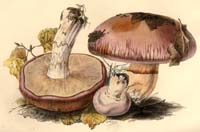 Key to Gilled Mushrooms Key
Key to Gilled Mushrooms KeyThis is a key to gilled mushrooms, that is, mushrooms having a definite cap with a fertile surface consisting of gills. The fruiting body usually also has a stem, although that may be lateral or absent (usually, then, the mushroom is growing from wood). You can use this key to identify mushrooms that you find.
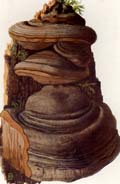 Polyporaceae Family
Polyporaceae FamilyFertile surface usually a layer of vertical tubes, of which the mouths are visible as pores on the underside of the cap or shelf.
Fruiting bodies usually tougher or harder than the "normal" gilled mushrooms, being leathery, corky, or woody. But they can be quite tender while actively growing
Once grown, they do not decay easily, remaining on the substrate for months or years
They often grow on wood, although a few are terrestrial (even those are usually growing on buried wood)
Fruiting body is usually a flat shelf, or hoof-shaped, protruding directly from the substrate, although sometimes it may have a short stalk.
Some forms never grow away from the substrate at all, so that all that is visible of the fruiting body are the pores.
Sometimes the pores are so minute that the fertile surface seems solid, until you look closely
 Lignicopolypore Subfamily
Lignicopolypore SubfamilyGrowing on wood
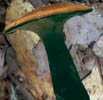 Stipitoporus Tribe
Stipitoporus TribeNot fitting the other choices, fruiting body with well-developed stem
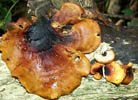 Polyporus Genus
Polyporus GenusCap lacking hard crusty upper surface or large, angular pores
Fruiting body flexible if it's not really thick
 Blackfoot Polypore Section
Blackfoot Polypore SectionStem black, at least towards the base
Here are the characters that distinguish this species from the others in its group. For its more general characters, see higher up on the page.
If there's just a few words or a microscopic feature here, a more thorough description can be found above.
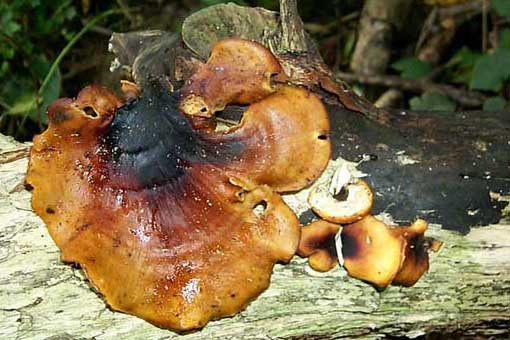
Diagnosis
- Thin-fleshed cap 2-8" across, often somewhat lobed; warm yellow-brown to reddish brown, darkening to black above the stem, often appearing shiny or velutinate
-
On hardwood stumps and logs
Comments
In some older books, most notably Lee Oras Overholts & J. L. Lowe's (1953) Polyporaceae of the United States, Alaska, and Canada, this species is called Polyporus picipes. But Polyporus badius won, I assume because Persoon published his name first. Polyporus arcularius

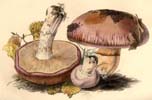


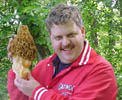

 Key to Gilled Mushrooms Key
Key to Gilled Mushrooms Key Polyporaceae Family
Polyporaceae Family Stipitoporus Tribe
Stipitoporus Tribe Polyporus Genus
Polyporus Genus Blackfoot Polypore Section
Blackfoot Polypore Section





